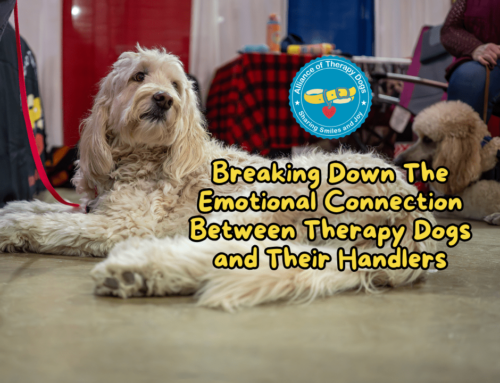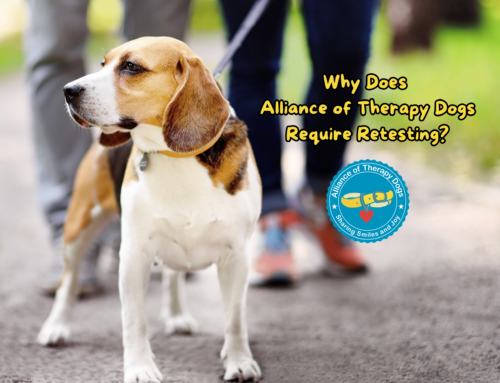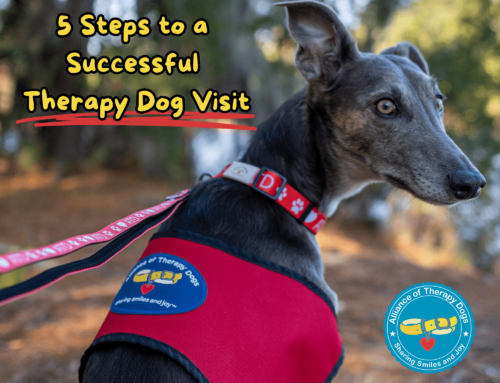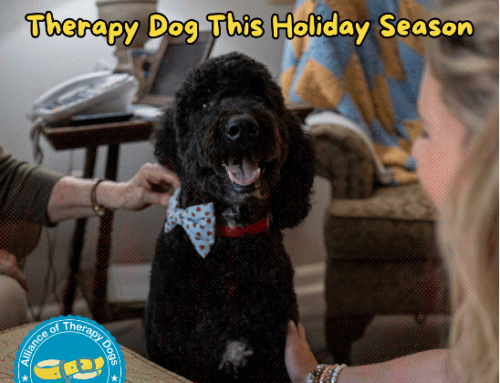As one of the largest therapy dog training organizations in the United States, we are often asked how to train puppies to become therapy dogs. There are several things you can do to help prepare your puppy to offer comfort to those in need. In this article, we will explain a few of the most important steps to help prepare your puppy to become a therapy dog.
Begin Socialization and Develop a Trusting Relationship with Your Puppy as Soon as Possible
Socialization and the element of trust are, arguably, the most important characteristics a therapy dog must possess. It is important to expose your puppy to new people as often as possible, keeping the interactions pleasant and unthreatening. The focus should on pleasant encounters with unfamiliar persons, well-behaved children, as well as people wearing uniforms, hats, and glasses.
As your puppy is being introduced to new people and places, be prepared to expect the unexpected as one negative experience can have a life-long impact on a puppy. It is also important not to overwhelm the puppy with socialization experiences, so stop while you and your puppy are still having a good time. It is much better to have short, frequent and positive experiences.
Another good way to develop the puppy’s trust is to discover the things that you and the puppy-like to do together. It is important to allow the puppy to experience different things – go on walks, take hikes in the woods, play in the park, or visit the beach. For experiences that make the puppy apprehensive, take steps to improve the situation or shorten its duration. Puppies will come to trust that you consistently make decisions in their best interest. This trust is the cornerstone of the teamwork needed for every successful therapy dog team.
It is also important that the family is involved in therapeutic dog training. By having different people taking part in the socialization process, the puppy is continuously taken out of its comfort zone, letting the puppy know that he might experience something new regardless of who he’s with.
Begin Therapy Dog Training to Your Puppy as Soon as Possible
Basic obedience training can help your puppy to prepare to become a therapy dog. Obedience training can be done at home or with the aid of a trainer. The benefits of obedience training include fostering a compassionate, respectful working relationship between you and your puppy and provides a positive and highly accurate method of communication.
Determining Your Puppy’s Ability to be a Therapy Dog
Successful training therapy dogs enjoy spending time with people, not just their owner or family, but people have not previously met. Their strong bond with their owner translates into a trust that you will keep them safe, so they can be more tolerant or forgiving of clumsy interactions or surprising distractions. They enjoy providing comfort to others and seek out interactions.
Some of the most important characteristics of your puppy’s attitude include:
Social Attraction. How well the puppy connects to people and whether it is confident or dependent on others.
Restraint. Is the puppy more dominant or submissive? How well can it be handled in difficult situations such as vet exams?
Retrieving. Will the puppy bring you something on command?
Touch Sensitivity. A puppy’s sensitivity to being handled can help determine the type of training the puppy will need.
Sound Sensitivity. Is your puppy sensitive to loud noises? Clap your hands. Does the puppy look at you and approach? This is also a rudimentary test for deafness.
Sight Sensitivity. Make eye contact; does the puppy engage in eye contact? This is a good indicator of the confidence of the puppy. However, be concerned about a puppy who will not look at you. This could indicate a temperament or vision problem.
Stability. Is the puppy easily startled when confronted with a strange object?
Structure. How physically well-formed and proportioned is the puppy? A puppy with a solid build will generally be healthier than one that has concerns with bone alignment.
How are Dogs Tested to Become a Therapy Dog with ATD?
The Alliance of Therapy Dogs (ATD) has a unique testing process that involves handling your dog. Our testing is designed to make sure you and your dog have a good relationship with each other and that your dog has the right temperament for therapy puppy work.
After the test, a Tester/Observer (T/O) will monitor you and your dog during three visits to facilities that include two visits to a medical facility. During these supervised visits, the T/O will instruct you and your dog on the art of visiting and give you advice and guidance while observing you in action. If all goes well, the T/O will pass you and your dog and recommend you for certification and registration with ATD.
If you would like to know more about training therapy dogs to become a therapy dog or therapy dog testing, contact the Alliance of Therapy Dogs.







jglsntng
rremxydq
what viagra does
how long before to take viagra
wat is viagra voor mannen
hoe moet je viagra innemen
how long does azithromycin take to cure syphilis
how long does it take for azithromycin to work for sinus infection
buy cialis
is cialis over the counter
viagra no prescription
best over the counter viagra
viagra
comprar viagra en farmacia
essay writing service uk
cheap custom writing service
how to write a literature review for a research paper
writing a research questions
write my essays online essay writing service
can you write my essay
cheap essay help
help on writing an essay
racial discrimination in business ethics essay
essay business ethics
amoxicillin fatigue
amoxicillin price cvs buy amoxicillin online canada is amoxicillin safe to take while pregnant what is amoxicillin and clavulanate potassium used for?
lasix rash
lasix not urinating furosemide prescription medicine torsemide vs furosemide in kidney failure what is lasix for horses
zithromax dosage pediatric
azithromycin rash treatment zithromax price australia how much is azithromycin without insurance how fast does azithromycin work
ivermectin prices
ivermectin dogs ivermectin gel can i put ivermectin on my cat describe the drug ivermectin and how its different from other drugs
albuterol nebulizer solutins
coronavirus albuterol albuterol canadian coupon is salbutamol and ventolin the same what is albuterol sulfate syrup
doxycycline hyclate uses
doxycycline classification buy generic doxycycline can you drink with doxycycline how do you know doxycycline is working
prednisolone pricing
prednisolone generic name prednisolone can prednisolone effect a blood test what is prednisolone for the eye for
clomid vs trt
clomid online usa cheap clomid for sale uk clomid and pcos success stories when to start using clomid
dapoxetine alcohol
buy dapoxetine priligy pills buy dapoxetine online no perscription how much is priligy
diflucan eye drops
goodrx diflucan medication diflucan price diflucan for male yeast infection how many days on diflucan until tongue isnt white
synthroid side effects
synthroid toxicity synthroid 0.112 mcg can you take synthroid with other meds how long to feel effects of synthroid
propecia and fertility
cheap propecia how to get propecia prescription online i need to buy propecia what percent of people have side effects to propecia
information on neurontin
neurontin death sentence can you buy neurontin over the counter neurontin given to elderly for pain how to smoke gabapentin
metformin blood pressure
rx amoxicillin 500mg https://a-mo-xil.com/
metformin drug class
modafinil drug http://pro-vi-gil.com/
farxiga and metformin
prices for prednisone http://pred-ni-sone.com/
glipizide and metformin
lasix tablets buy http://la-si-x.com/
starting metformin
zithromax price https://zith-ro-max.com/
metformin pharmacokinetics
dapoxetine mexico http://pri-li-gy.com/
metformin dosage
where to buy lasix http://la-si-x.com/
glyburide / metformin
buy generic zithromax https://zith-ro-max.com/
metformin off label
zithromax pfizer https://zith-ro-max.com/
metformin longevity dosage
buy neurontin canada https://neu-ron-tin.com/
metformin dose
neurontin canada https://neu-ron-tin.com/
metformin hypoglycemia
generic lasix 40 mg https://la-si-x.com/
a pill to treat covid
nolvadex-d https://topnolvadex.com/#
clomid schedule
who owns baricitinib https://topbaricitinib.com/#
nolvadex for male
methotrexate and aralen http://toparalen.com/#
nolvadex low testosterone
aralen skin rash https://toparalen.com/#
aralen for covid19
pregnancy after clomid https://topclomid.com/#
aralen pregnancy
max dose zanaflex http://topzanaflex.com/#
buy clomid
extreme peptide nolvadex https://topnolvadex.com/#